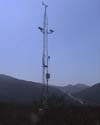Calit2 Teams with SDSU
 Calit² and San Diego State University (SDSU) signed a Memorandum of Understanding September 14 2001 to develop an infrastructure for real-time access to, and analysis of, data from the field to study environmental problems. This infrastructure will be based on regional, state-of-the-art telecommunications and information technology. First steps include
Calit² and San Diego State University (SDSU) signed a Memorandum of Understanding September 14 2001 to develop an infrastructure for real-time access to, and analysis of, data from the field to study environmental problems. This infrastructure will be based on regional, state-of-the-art telecommunications and information technology. First steps include
- designing and siting sensor instrumentation to monitor characteristics of water and air quality in field stations managed by SDSU, especially the Santa Margarita Ecological Reserve and the Tijuana Estuary
- applying the power of optically connected immersive environment data-analysis facilities at UCSD and SDSU to visualize, analyze, and understand the data
This work is supporting Calit²’s longer-term goal of establishing an infrastructure to demonstrate the power of science-based, collaborative decision making.
Says Calit² director Larry Smarr, “We're developing a three-tier infrastructure. First we’re establishing networks of sensors in the field to supply data, which will be accessible in real time or subsequently from archives. Second, we’re establishing collaborative crisis management centers to analyze and understand the data. And third, we’re making it possible for, in this case, scientists such as ecologists in the field to interrogate stored data remotely through wireless links.”
Such crisis management facilities are envisioned to be able to provide vital information in a timely way to citizens at home and emergency response workers in the field. With this goal in mind, this system is being designed to enable quick and effective response to natural disasters, such as earthquake, hurricane, or floods, and man-made disasters such as pollution events, or airplane or traffic crashes.
Central to the crisis management capabilities are two facilities being established at the Scripps Institution of Oceanography, UCSD, and San Diego State University. These facilities, linked by fiber optics provided by Cox Communications, center on large, curved-screen GVR-120 VisCenter displays from Panoram Technologies. Driving the Panoram display at SIO is an SGI Onyx 2/3400 and TeraBurst Networks is expected to provide optical networking systems at both facilities based on a hybrid solution that transmits several wavelengths on a single fiber and supports applications. Their systems provide the benefits of both digital and photonic technologies.
To create this infrastructure requires a multidisciplinary team of researchers and field personnel working across an unusually broad range of disciplines including, on the applications end, botany, chemistry, ecology, geology, hydrology, seismology, and zoology, and, on the technology end, computer science, electrical engineering, materials science, and telecommunications. What’s particularly exciting here is the understanding of common cause among disciplines that traditionally have not worked together.
Says SDSU professor Eric Frost, the SDSU liaison with Calit², “This type of telecommunications linkage between scientists, engineers, and decision makers will help our two universities solve problems of global impact. By developing practical applications that touch every branch of science, engineering, and other fields such as urban planning and public health, the wireless and immersive environments that Calit² is putting in place will provide a showcase for technology to help move society into the future."
This infrastructure is also expected to support environment-related degree programs at both campuses, including a new Environmental Systems major at UCSD that integrates the natural with the social sciences, and the University of California “Hands-On Science for Teachers” program. The system should also enhance academic collaboration between the two universities, especially several joint Ph.D. programs that exist or are in the approval process.
Related Links
SMER
SDSU Field Stations
ROADNet
HPWRENCalit² & SMER
Activities
Living Labs
